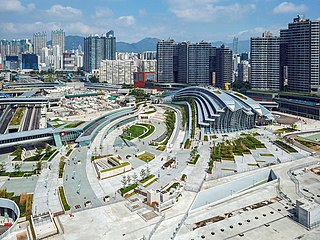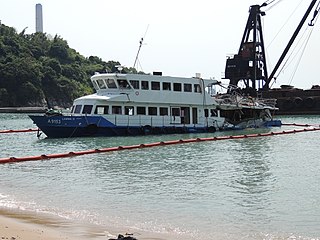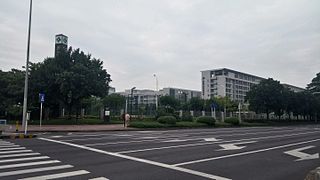
The People's Liberation Army Hong Kong Garrison is a garrison of the People's Liberation Army (PLA), responsible for defence duties in the Hong Kong Special Administrative Region (SAR) since the sovereignty of Hong Kong was transferred to China in 1997. Prior to the handover of Hong Kong, the territory was under British rule, and the defence of the territory was the responsibility of the British Forces Overseas Hong Kong, with auxiliary help from the Royal Hong Kong Regiment.
Cheung Tze-keung was a notorious Hong Kong gangster also known as "Big Spender". He was a kidnapper, robber, arms smuggler and was wanted for murder. He was best known for having masterminded the abduction of Walter Kwok and Victor Li, son of Li Ka Shing.

Cheung Tsing Highway is a highway of Route 3 between Cheung Tsing Tunnel and North West Tsing Yi Interchange on Tsing Yi Island, New Territories, Hong Kong. It was built as part of the Airport Core Programme together with the rest of Route 3 to provide a new highway link from North Western New Territories towards Hong Kong Island, and connects with Route 8 to provide access to the new Hong Kong International Airport.

The Liaison Office of the Central People's Government in the Hong Kong Special Administrative Region is the representative office of the State Council of the People's Republic of China in Hong Kong.

The Hong Kong section of the Guangzhou–Shenzhen–Hong Kong Express Rail Link is a 26 km (16 mi) long stretch of high-speed rail that runs along a dedicated underground rail corridor linking Hong Kong to mainland China. It is one of the most expensive infrastructure undertakings in Hong Kong's history. The line connects Kowloon with the high-speed rail network of China at Futian station in the technology hub of Shenzhen, then running north towards the commercial/ political hub of Guangzhou. As of August 2023 the line has an average ridership of 79,000 passengers a day.

West Kowloon station, also known as Hong Kong West Kowloon, is the southern terminus of and the only station on the Hong Kong section of the Guangshengang XRL. The station connects to China's high-speed rail (HSR) network across the border through dedicated tunnels and includes a Mainland Port Area where the laws of (Mainland) China are enforced. It was constructed by the MTR Corporation Limited as the project manager commissioned by the Hong Kong Government, through subcontractors.

The Ritz-Carlton, Hong Kong is the highest five-star hotel in Hong Kong and third highest in the world. The Ritz-Carlton is a brand of the American company Marriott International. It was the world's highest hotel when opened in March 2011, until it was surpassed by the J Hotel Shanghai Tower in December 28, 2020.

The Luohu Port is a port of entry/border crossing between mainland China and Hong Kong, located in Luohu District of Shenzhen and Lo Wu, New Territories of Hong Kong. It sits within the Frontier Closed Area. The control point is integrated with Lo Wu station of the Mass Transit Railway (MTR) and Luohu station of the Shenzhen metro, the Hong Kong counterpart being Lo Wu Control Point.

On 1 October 2012, at approximately 20:23 HKT, the passenger ferries Sea Smooth and Lamma IV collided off Yung Shue Wan, Lamma Island, Hong Kong. This occurred on the National Day of the People's Republic of China, and one of the ships was headed for the commemorative firework display, scheduled to take place half an hour later. With 39 killed and 92 injured, the incident was the deadliest maritime disaster in Hong Kong since 1971.

"Bill" Tang Ka-piu is a Hong Kong politician who currently served as a legislative councillor and district councillor (2007–2019).

The following is an overview of public housing estates in the Kai Tak development area, Kowloon City District, Hong Kong, including Home Ownership Scheme (HOS), Private Sector Participation Scheme (PSPS), and Tenants Purchase Scheme (TPS) estates.
Kevin Lau , former editor-in-chief of the Hong Kong daily newspaper Ming Pao, was attacked in the morning of 26 February 2014 as he was getting out of his car in Lei King Wan, Hong Kong by two men who were waiting for him. Lau suffered stab wounds to his back and legs. He was rushed to a hospital, where he underwent emergency surgery. The police and most commentators agree that it was a triad-style attack aimed at maiming without killing.

Ten Years is a 2015 Hong Kong speculative fiction anthology film, featuring a vision of the semi-autonomous territory in the year 2025, with human rights and freedoms gradually diminishing as the Chinese government exerts increasing influence there. Produced on a shoestring budget, the film was a surprise hit, beating Star Wars: The Force Awakens at the Yau Ma Tei cinema where it was first released. It was released on Netflix in February 2019.

Lam Wing-kee is a Hong Kong businessman and book seller. He is the owner of Causeway Bay Books in Taipei, a book store first located in Causeway Bay in Hong Kong and most well known for its provision of politically related publications. In late 2015, he went missing along with four other staff members of the book store, sparking international concern.

The University of Hong Kong–Shenzhen Hospital is a teaching hospital of the University of Hong Kong in Futian, Shenzhen, Guangdong, China.
Events in the year 2018 in Hong Kong.

41 Cumberland Road is the address of Bruce Lee's former home in Kowloon Tong, Kowloon, Hong Kong, where he spent his last year with his family. The place was affectionately known as "the Crane's Nest".

The 2019–2020 Hong Kong protests were a series of demonstrations against the Hong Kong government's introduction of a bill to amend the Fugitive Offenders Ordinance in regard to extradition. It was the largest series of demonstrations in the history of Hong Kong.

Luo Changqing, a 70-year-old Hong Kong cleaner, died from head injuries sustained after he was hit by a brick thrown by a Hong Kong protester during a violent confrontation between two groups in Sheung Shui, Hong Kong on 13 November 2019. Following his injuries, he was taken to Prince of Wales Hospital, Sha Tin, where he died the next day. This incident was described as the first fatality directly attributed to the Hong Kong protests that began in 2019.

Few protests took place in December 2020 and there was no large-scale demonstrations in threat of the national security law. The imprisonment of Joshua Wong, Agnes Chow and Ivan Lam on 2 December aroused attention of the International community.



















